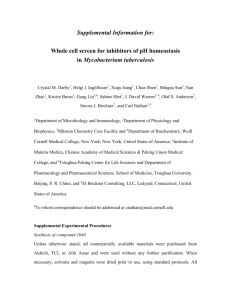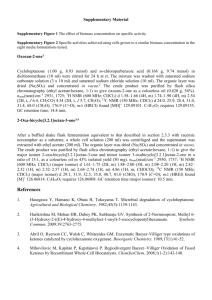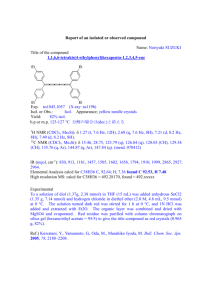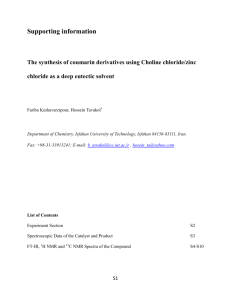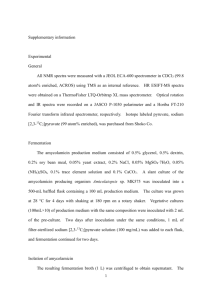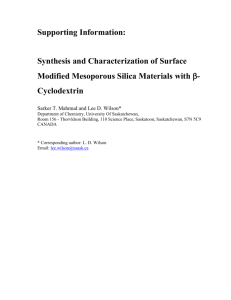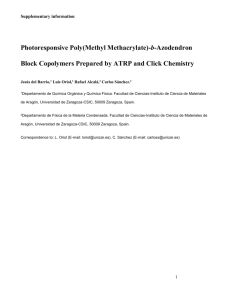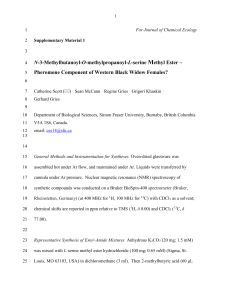Document 13308405
advertisement
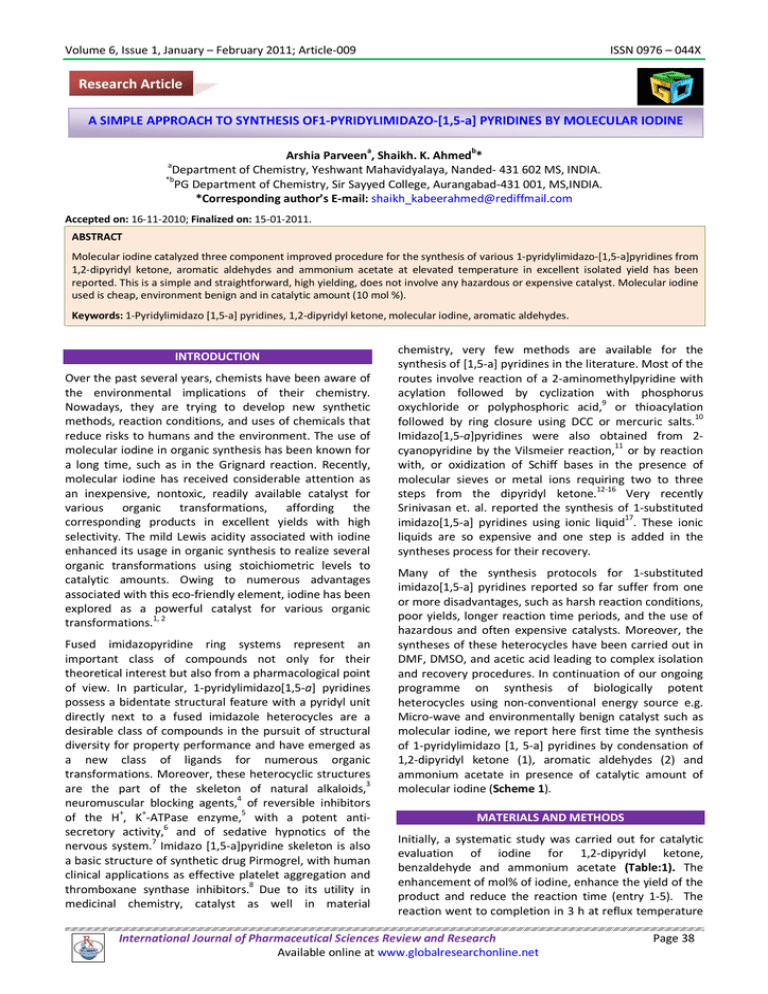
Volume 6, Issue 1, January – February 2011; Article-009 ISSN 0976 – 044X Research Article A SIMPLE APPROACH TO SYNTHESIS OF1-PYRIDYLIMIDAZO-[1,5-a] PYRIDINES BY MOLECULAR IODINE a b Arshia Parveen , Shaikh. K. Ahmed * Department of Chemistry, Yeshwant Mahavidyalaya, Nanded- 431 602 MS, INDIA. *b PG Department of Chemistry, Sir Sayyed College, Aurangabad-431 001, MS,INDIA. *Corresponding author’s E-mail: shaikh_kabeerahmed@rediffmail.com a Accepted on: 16-11-2010; Finalized on: 15-01-2011. ABSTRACT Molecular iodine catalyzed three component improved procedure for the synthesis of various 1-pyridylimidazo-[1,5-a]pyridines from 1,2-dipyridyl ketone, aromatic aldehydes and ammonium acetate at elevated temperature in excellent isolated yield has been reported. This is a simple and straightforward, high yielding, does not involve any hazardous or expensive catalyst. Molecular iodine used is cheap, environment benign and in catalytic amount (10 mol %). Keywords: 1-Pyridylimidazo [1,5-a] pyridines, 1,2-dipyridyl ketone, molecular iodine, aromatic aldehydes. INTRODUCTION Over the past several years, chemists have been aware of the environmental implications of their chemistry. Nowadays, they are trying to develop new synthetic methods, reaction conditions, and uses of chemicals that reduce risks to humans and the environment. The use of molecular iodine in organic synthesis has been known for a long time, such as in the Grignard reaction. Recently, molecular iodine has received considerable attention as an inexpensive, nontoxic, readily available catalyst for various organic transformations, affording the corresponding products in excellent yields with high selectivity. The mild Lewis acidity associated with iodine enhanced its usage in organic synthesis to realize several organic transformations using stoichiometric levels to catalytic amounts. Owing to numerous advantages associated with this eco-friendly element, iodine has been explored as a powerful catalyst for various organic 1, 2 transformations. Fused imidazopyridine ring systems represent an important class of compounds not only for their theoretical interest but also from a pharmacological point of view. In particular, 1-pyridylimidazo[1,5-a] pyridines possess a bidentate structural feature with a pyridyl unit directly next to a fused imidazole heterocycles are a desirable class of compounds in the pursuit of structural diversity for property performance and have emerged as a new class of ligands for numerous organic transformations. Moreover, these heterocyclic structures 3 are the part of the skeleton of natural alkaloids, 4 neuromuscular blocking agents, of reversible inhibitors of the H+, K+-ATPase enzyme,5 with a potent antisecretory activity,6 and of sedative hypnotics of the 7 nervous system. Imidazo [1,5-a]pyridine skeleton is also a basic structure of synthetic drug Pirmogrel, with human clinical applications as effective platelet aggregation and 8 thromboxane synthase inhibitors. Due to its utility in medicinal chemistry, catalyst as well in material chemistry, very few methods are available for the synthesis of [1,5-a] pyridines in the literature. Most of the routes involve reaction of a 2-aminomethylpyridine with acylation followed by cyclization with phosphorus oxychloride or polyphosphoric acid,9 or thioacylation followed by ring closure using DCC or mercuric salts.10 Imidazo[1,5-a]pyridines were also obtained from 2cyanopyridine by the Vilsmeier reaction,11 or by reaction with, or oxidization of Schiff bases in the presence of molecular sieves or metal ions requiring two to three steps from the dipyridyl ketone.12-16 Very recently Srinivasan et. al. reported the synthesis of 1-substituted imidazo[1,5-a] pyridines using ionic liquid17. These ionic liquids are so expensive and one step is added in the syntheses process for their recovery. Many of the synthesis protocols for 1-substituted imidazo[1,5-a] pyridines reported so far suffer from one or more disadvantages, such as harsh reaction conditions, poor yields, longer reaction time periods, and the use of hazardous and often expensive catalysts. Moreover, the syntheses of these heterocycles have been carried out in DMF, DMSO, and acetic acid leading to complex isolation and recovery procedures. In continuation of our ongoing programme on synthesis of biologically potent heterocycles using non-conventional energy source e.g. Micro-wave and environmentally benign catalyst such as molecular iodine, we report here first time the synthesis of 1-pyridylimidazo [1, 5-a] pyridines by condensation of 1,2-dipyridyl ketone (1), aromatic aldehydes (2) and ammonium acetate in presence of catalytic amount of molecular iodine (Scheme 1). MATERIALS AND METHODS Initially, a systematic study was carried out for catalytic evaluation of iodine for 1,2-dipyridyl ketone, benzaldehyde and ammonium acetate (Table:1). The enhancement of mol% of iodine, enhance the yield of the product and reduce the reaction time (entry 1-5). The reaction went to completion in 3 h at reflux temperature International Journal of Pharmaceutical Sciences Review and Research Available online at www.globalresearchonline.net Page 38 Volume 6, Issue 1, January – February 2011; Article-009 with 10 mol% I2. Accordingly, 10 mol% was sufficient to catalyze the reaction. A rate enhancement with high yield was observed when higher molar ratios of I2 were used. However, no product formation was observed in absence of I2. Tab 1: Catalytic evaluation of iodine for the synthesis of 3 Entry Catalyst (I2) (mol %) Time (h) Yield (%) 1 0 12 00 2 2 12 65 3 5 7 90 4 10 3 96 5 15 2.5 94 a,b a : Reaction Condition; 1,2-dipyridyl ketone (10 mmol), benzaldehyde (10 mmol), ammonium acetate (20 mmol), EtOH (10 mL), 75 0C; b: Isolated yield after column chromatography. Entry 1 2 3 4 5 6 7 Table 3: Study of temperature effect for the synthesis of 3 in ethanol 1 2 3 4 5 a Temp. 0 ( C) 00 40 50 60 75 To check the efficiency of molecular iodine catalyst we also tried several conventional acid catalysts or acid under identical conditions, results are showed in (Table2). When conventional Lewis acids such as AlCl3, TiCl4, ZnCl2 used under identical condition it gave product 20, 10 and 40 % isolated yield, where as pTSA gave traces of product. AcOH gave 70% of product after 6 h, which was replaced by strong acids such as H2SO4 and PPA (poly phosphoric acid) there is progressive increase in yield of product and drop out of reaction time, but problem with using these acid catalyst is the critical isolation method and generation hazardous waste material. Toluene, acetonitrile, methanol and ethanol were found to be suitable solvent, where as solvents such as DMF, DMSO, DCM does not gave products in satisfactory amount. As we found that ethanol is best solvent, we proceeded with ethanol, which is considered as a relatively benign organic solvent (Table 2). Table 2: Study of different acid catalyst for the synthesis of 3 Acid catalyst/acid (mol%) Solvent/Temp. (0C) Time (h) AlCl3 (20 mol%) EtOH/reflux 12 TiCl4 (20 mol%) EtOH/reflux 12 pTSA (20 mol%) EtOH/reflux 12 ZnCl2 (30 mol%) CH3CN/reflux 12 AcOH AcOH/110 6 H2SO4 H2SO4/80 4 PPA PPA/80 3 It is important to note that in case of ethanol, 1pyridylimidazo [1,5-a] pyridines 3 precipitated on dilution of the reaction mixture with an aqueous solution of Na2S2O3 and were isolated by simple filtration. Whereas in other hazardous solvents, the extraction step for the isolation of the products were required. At room temperature no product formation was observed even after 12 h, however, with increase in temperature, product 3 was obtained within few hours (Table3). Entry ISSN 0976 – 044X Time (h) 12 12 12 8 3 Yield a (%) 00 30 75 92 94 : Isolated yield after column chromatography. After getting these encouraged results, we have extended the methodology to a variety of aromatic aldehydes, which are summarized in Table 4. This method is effective for the preparation of 1-pyridylimidazo [1,5-a] pyridines 3 Yield a (%) 20 10 Traces 40 70 90 90 from both electrons efficient as well as electron deficient aromatic aldehydes. The aryl groups substituted with different groups and also the same groups located at different positions of the aromatic ring did not show any marginal effect on the formation of 1-pyridylimidazo [1,5a] pyridines 3. Another advantage of this methodology is, nearly stoichiometric amount of ammonium acetate was used in the course of the reaction, whereas previously many-fold of ammonium acetate was required. This is an additional advantage of the novel methodology. Molecular I2 due to it lewis acidic nature is capable of binding with the carbonyl oxygen increasing the reactivity of the parent carbonyl compound (schem:2).Iodine facilitates the formation of the imine intermediate, which under mild acid catalysis of I2 condenses further with the carbonyl carbon of the 1,2-dipyridylketone followed by dehydration to afford the intermediate (III), which rearranges to the required 1-pyridylimidazo[1,5-a] pyridines 3. General Experimental Method The 1H-NMR spectra were recorded on a Bruker AC-200 spectrometer with TMS as internal standard with 200 MHz frequency; chemical shifts (δ scale) are reported in parts per million (ppm) relative to the central peak of the solvent. 1H-NMR Spectra are reported in order: International Journal of Pharmaceutical Sciences Review and Research Available online at www.globalresearchonline.net Page 39 Volume 6, Issue 1, January – February 2011; Article-009 ISSN 0976 – 044X multiplicity, approximate coupling constant (J value) in hertz (Hz) and number of protons; signals were characterized as s (singlet), d (doublet), t (triplet), m 13 (multiplet), br s (broad signal). The C-NMR spectra were recorded at 50 MHz; chemical shifts (δ scale) are reported in parts per million (ppm). IR spectra were recorded on ATI MATTSON RS-1 FTIR spectrometer. Melting points were recorded in an open capillary. The crude products were purified by column chromatography using silica gel (60–120 mesh size). General Procedure for the Synthesis of 1-pyridylimidazo [1,5-a]pyridines 3 A mixture of 1,2-dipyridyl ketone1(10mmol), aromatic aldehyde 2(10mmol), ammonium acetate (20mmol) and 0 iodine (10mol%) in ethanol (10 ml) was stirred at 75 C for the time specified in Table 3. The completion of the reaction was monitored by TLC. After completion of reaction, the reaction mixture was diluted with water (containing 15% sodium bisulphate). The separated solid products were filtered off, washed with water, and dried. The crude products thus obtained were purified by column chromatography on silica gel (60–120 mesh size) using 25% ethylacetate in petroleum ether as eluent to yield 3. Scheme 1: synthesis of 1-substituted imidazo[1,5-a] pyridines Scheme 2: International Journal of Pharmaceutical Sciences Review and Research Available online at www.globalresearchonline.net Page 40 Volume 6, Issue 1, January – February 2011; Article-009 ISSN 0976 – 044X Table 4: Synthesis of 1-Pyridylimidazo [1,5-a] pyridines (3a-n) Aldehyde Product Time (h). Entry CHO N 1 N Yield (%) 3 9315 4 9215 4.5 9115 3 9115 3 92 4 9015 4.5 9115 4 9115 4.5 8815 4 9415 3.5 8715 4.5 9215 3 9415 4 9015 N 3a CHO N 2 N MeO N 3b M eO CHO N 3 N N 3c CHO N 4 N N OH 3d OH CHO N 5 N 15 N HO 3e HO CHO N 6 HO N N 3f OH CHO N 7 N Cl MeO N 3g Cl CHO N 8 M eO HO N N 3h HO O 2N CHO 9 N O 2N N N 3i CHO N 10 N HO N HO 3j Cl Cl CHO 11 N N Cl N 3k Cl CHO N 12 N OH N OH OMe 3l OMe MeO CHO N 13 M eO N N HO HO OMe CHO 14 3m OM e N N NH2 N H2 N 3n International Journal of Pharmaceutical Sciences Review and Research Available online at www.globalresearchonline.net Page 41 Volume 6, Issue 1, January – February 2011; Article-009 Spectroscopic and analytical data: 1-(2-Pyridyl)-3-phenylimidazo [1,5-a]pyridine(3a): Yellow solid, mp 91-92 0C. IR (CHCl3, cm-1): υmax 646,761, 960, 1 1404, 1565, 1633, 2224, 2933. H NMR (200 MHz, CDCl3): δ 6.61 (t, J = 6.5, 1H), 6.87 (dd, J = 9, 1H) 7.04 (t, J = 6.5, 1H), 7.43 (t, J = 7.5, 1H), 7.49 (t, J = 7.5, 2H), 7.66 (t, J = 7.5, 1H), 7.79 (d, J = 7.5, 2H), 8.20 (d, J = 7.5, 2H), 8.57 (d, J = 4.5, 1H), 8.67 (d, J = 9, 1H). 13C NMR (50 MHz, CDCl3) : δ 116.9, 119.7, 120.3, 120.8, 121.5, 121.7, 128.3, 128.8, 128.9, 129.8, 130.1, 130.3, 136.1, 137.8, 148.8, 154.9. Anal. Calcd. for C18H13N3: C, 79.68; H, 4.83; N, 15.49. Found C, 79.25; H, 4.49; N, 15.27. LC-MS: m/z = 272.(M+) 1-(2-Pyridyl)-3-(4-methoxy-phenyl) imidazo [1,5-a] pyridine (3b): yellow solid, mp 120-121 0C. IR (CHCl3, cm1 ): υmax 765, 850, 1050, 1321, 1509, 1633, 2248, 2850. 1H NMR (200 MHz, CDCl3): δ 3.81 (s, 3H), 6.56 (t, J = 7.7, 1H), 6.84 (dd, J = 9.0, 6.4, 1H), 6.95-7.04 (m, 3H), 7.59-7.69 (m, 3H), 8.18 (dd, J = 8.19, 7.3 2H), 8.57 (d, J = 5.85, 1H), 8.60 (d, J = 9.34, 1H). 13C NMR (50 MHz, CDCl3): δ 55.4, 113.7, 114.3, 119.8, 120.2, 120.7, 121.5, 122.3, 122.6, 129.7, 129.9, 130, 136.1, 138, 148.7, 154.6, 160. Anal. Calcd. for C19H15N3O: C, 75.73; H, 5.02; N, 13.94. Found C, 75.45; H, 4.59; N, 13.41. LC-MS: m/z =302.(M+) 1-(2-Pyridyl)-3-(2-methyl-phenyl) imidazo [1,5-a] pyridine (3c): yellow solid, mp 114-115 0C. IR (CHCl3, cm1 ): υmax 725, 810, 900, 1050, 1520, 1635, 1862, 2840, 3021. 1H NMR (200 MHz, CDCl3/DMSO-d6): δ 2.20 (s, 3H), 6.55 (t, J = 6.5, 1H), 6.87 (dd, J = 9, 6.3, 1H), 7.03 (t, J =6.5, 1H), 7.21-7.35 (m, 3H), 7.44 (d, J = 7.5, 1H), 7.56 (d, J = 7.5, 1H), 7.64 (t, J = 8, 1H), 8.16 (d, J = 8, 1H), 8.57 (d, J = 4.5, 1H), 8.65 (d, J = 9, 1H). 13C NMR (50 MHz, CDCl3/DMSO-d6): δ 19.7, 113.5, 119.8, 120.4, 121, 121.5, 121.6, 126.2, 129, 129.7, 129.8, 130.5, 130.8, 136.3, 137.7, 138.6, 139.1, 148, 152.6. Anal. Calcd. for C19H15N3: C, 79.98; H, 5.30; N, 14.73. Found C, 79.6; H, 5.09; N, 14.42. LC-MS: m/z = 285.(M+) 1-(2-Pyridyl)-3-(2-hydroxy-phenyl) imidazo [1,5-a] pyridine (3d): pale yellow solid, mp 195-196 0C. IR (CHCl3, cm-1): υmax 759, 964, 1260, 1315, 1630, 2400, 3450. 1H NMR (200 MHz, CDCl3/DMSO-d6): δ 5.05 (s, 1H), 7.17 (t, J = 6.8, 1H), 7.33-7.53 (m, 4H), 7.75 (t, J = 8,1H), 8.17 (d, J = 7.91, 2H), 8.51 (d, J = 7.78, 1H), 8.65 (d, J = 6.77, 1H), 9 (d, J = 4.5, 1H), 9.11 (d, J = 9.26, 1H). 13C-NMR (50 MHz, CDCl3/DMSO-d6): δ 116.2, 120.5, 121.6, 122.0, 122.2, 122.4, 123.6, 123.7, 128.4, 129.9, 135.7, 135.7, 136.3, 136.9, 149.8, 150.0,155.8,157.4. Anal. Calcd. for C18H13N3O: C, 75.25; H, 4.56; N, 14.63. Found C, 74.71; H, 4.07; N, 14.28. LC-MS: m/z = 288.(M+) 1-(2-Pyridyl)-3-(4-hydroxy-phenyl) imidazo [1,5-a] 0 pyridine (3e): pale yellow solid, mp 194-195 C. IR (CHCl3, -1 1 cm ): υmax 759, 964, 1260, 1315, 1630, 2400, 3450. H NMR (200 MHz, CDCl3/DMSO-d6): δ 8.80 (d,J=9.0,1H), 8.60 (d, J = 5.8,1H), 8.12 (dd,J=8.0, 2H), 7.69-7.51 (m, 3H), 7.36 (dd, J = 91,1H), 6.83-7.02 (m,3H), 6.62 (t J = 6.7, 13 1H), C-NMR (50 MHz, CDCl3/DMSO-d6): δ =154.4,154.4,149.3,147, 144.3,138.6,129.5, 128.3, 120.6, 119.8,117.1, 114.7. Anal. Calcd. for C18H13N3O: C, 75.25; ISSN 0976 – 044X H, 4.56; N, 14.63. Found C, 74.71; H, 4.07; N, 14.28. LCMS: m/z = 288.(M+) 1-(2-Pyridyl)-3-(3-hydroxy-phenyl) imidazo [1,5-a] 0 pyridine (3f): yellow solid, mp 200-201 C. IR (CHCl3, cm 1 1 ): υmax 629, 763, 825, 1455, 1657, 2127, 2254, 3360. H NMR (200 MHz, CDCl3/DMSO-d6): δ 5.00 (s, 1H), 6.727.04 (m, 5 H), 7.08-7.14 (m, 1H), 7.30-7.34 (d, J = 8.03, 1H), 7.70-7.78 (m, 1H), 8.12-8.16 (d, J = 8.08, 1H), 8.368.41 (d, J = 7.08, 1H), 8.56-8.57 (d, J = 5.6, 1H), 8.60-8.63 13 (d, J = 9.25, 1H); C-NMR (50 MHz, CDCl3/DMSO-d6): δ 114.2, 115.7, 119.6, 120.5, 122.0, 122.3, 123.6, 130.4, 135.7 ,136.9, 137.9, 149.8, 150.0, 157.4, 157.8. Anal. Calcd. for C18H13N3O: C, 75.25; H, 4.56; N, 14.63. Found C, 74.82; H, 4.42; N, 14.48. LC-MS: m/z =287.(M+) 1-(2-Pyridyl)-3-(2-chloro-phenyl) imidazo [1,5-a] pyridine 0 -1 (3g): bright yellow solid, mp 178-179 C. IR (CHCl3, cm ): 1 υmax 708, 821, 1052, 1453, 1635, 2469, 3080. H NMR (200 MHz, CDCl3): δ 6.61-6.66 (m, 1H), 6.91-6.97 (m, 1H), 7.17.15 (m, 1H), 7.37-7.73(m, 6H), 8.17-8.25 (m, 1H), 8.608.64 (m, 1H), 8.68-8.75 (m, 1H). 13C NMR (50 MHz, CDCl3): δ 113.5, 119.6, 120.4, 121.1, 121.4, 122.1, 127.2, 129.1, 129.6, 129.8, 130.7, 133.2, 134.3, 135.6, 136.1, 148.9, 154.5. Anal. Calcd. for C18H12N3Cl: C, 70.71; H, 3.91; N, 13.70.Found: C, 70.09; H, 3.41; N, 13.29. LC-MS: m/z =306.(M+) 1-(2-Pyridyl)-3-(3-methoxy-4-hydroxyphenyl) imidazo [1,5-a] pyridine (3h): yellow solid, mp 132-133 0C: υmax 1 ,665, 820, 910, 1216, 1404, 1589, 1677, 2962, 3019. H NMR (200 MHz, CDCl3/DMSO-d6): δ 3.72(s, 3H), 5.13(br s, 1H), 6.48-6.41(t, J = 9.1, 1H), 6.74-6.65(m, 1H), 6.92-6.81 (m, 2H), 7.05-7.00 (m, 1H) 7.14-7.12 (m, 1H), 7.56-7.47 (m, 1H), 7.99 (d, J =9.6, 2H), 8.4-8.3 d, J = 8.4, 2H),13CNMR (50 MHz, CDCl3/DMSO-d6): δ 153.8, 147.9, 147.4, 146.8, 137.7, 135.7, 129.1, 128.6, 127.5 , 121.8, 120.5,120.4, 120.3, 120.2, 119.6, 119.0, 114.9,113.1, 111.5, 55.2 Anal Calcd. for C19H15N3O2: C, 71.91; H, 4.76; N, 13.24. Found: C, 71.54; H, 4.38; N, 13.12. LC-MS: m/z = 318.(M+) 1-(2-Pyridyl)-3-(3-nitro-phenyl) imidazo [1,5-a] pyridine 0 -1 (3i): yellow solid, mp 187-188 C. IR (CHCl3, cm ): υmax 1 840, 914, 1210, 1335, 1560, 1620, 1810, 2100. H NMR (200 MHz, CDCl3/DMSO-d6): δ 6.8 (t, J = 7, 1H), 7.09(t, J =7, 1H), 7.12 (t, J = 7, 1H), 7.79-7.8 (m, 2H), 8.10 (d, J = 8, 1H), 8.26 (d, J = 7.5, 1H), 8.34 (d, J = 7, 1H), 8.57-8.6 (m, 4H). 13C-NMR (50 MHz, CDCl3/DMSO-d6): δ 115.8, 120, 121.5, 121.8, 123.2, 123.3, 123.7, 125,130, 131, 131.3, 131.7,134, 136, 138.1, 149, 149.5, 155. Anal Calcd. for C18H12N4O2: C, 68.35; H, 3.82; N, 17.71. Found: C, 67.83; H, 3.39; N, 17.32. LC-MS: m/z =317.(M+) 1-(2-Pyridyl)-3-(3, 5-di-tert-butyl-4-hydroxy-phenyl) 0 imidazo [1,5-a] pyridine (3j): yellow solid, mp 212-213 C. -1 IR (CHCl3, cm ): υmax 669, 710, 1036, 1352, 1430, 1633, 1 2400, 3435. H NMR (200 MHz, CDCl3) δ 1.5 (s, 18H), 5.45 (brs, 1H), 6.84-6.92 (m, 1H), 7.03-7.1 (m, 1H), 7.58 (s, 2H), 7.66-7.74 (m, 1H), 8.12-8.16 (d, J = 7.28, 1H), 8.24-8.28 13 (d, J = 8.48, 1H), 8.60-8.71 (m, 2H). C NMR (50 MHz, CDCl3): δ 30.2, 113.5, 119.9, 120.2, 120.7, 121.7, 125.6, International Journal of Pharmaceutical Sciences Review and Research Available online at www.globalresearchonline.net Page 42 Volume 6, Issue 1, January – February 2011; Article-009 ISSN 0976 – 044X 136.2. Anal Calcd. for C26H29N3O: C, 78.16; H, 7.32; N, 10.52. Found C, 77.89; H, 6.89; N, 9.92. LC-MS: m/z =400.(M+) Mahajan, S.; Janda, K. D. Synlett, 2005, 1325. (c) Sun, J.; Dong, Y., Cao, X.; Wang, X.; Wang, S.; Hu, Y. J. Org. Chem. 2004, 69, 8932. 1-(2-Pyridyl)-3-(5-methoxy-6-hydroxyphenyl) imidazo 0 [1,5-a] pyridine (3l): yellow solid, mp 184-185 C. υmax ,660,690, 820, 910, 1216, 1404, 1589, 1630, 2966, 3019. 1 H NMR (200 MHz, CDCl3) δ 11.50 (s, br,1H), 8.72 (m, 1H), 8.84-8.92 (m, 1H), 8.03 (m, 1H), 8.38 (m, 1H), 7.66-7.74 (m, 1H), 7.37-8.16 (m, 1H),7.05 (m, 1H),6.86 (m, 3H), 6.66 13 13 (m, 1H), 3.5 (s,3H) C NMR (50 MHz, CDCl3): δ C-NMR (50 MHz, CDCl3/DMSO-d6): δ 154.8, 149.9, 147.4, 146.2, 136.7, 135.7, 129.4, 128.6, 126.5 , 122.8, 121.5,120.4, 120.3, 120.2, 119.8, 119.0, 118,114,113.2, 111.5, 55.2 Anal Calcd. for C19H15N3O2: C, 71.91; H, 4.76; N, 13.24. Found: C, 71.81; H, 4.86; N, 12.90 LC-MS: m/z = 317.(M+) 2. Pkan P. J. Org. Chem. 2004, 69, 4005. 3. Biachi, G.; Rodrigues, A.; Yakurshigiu, K, J. Org. Chem. 1989, 54, 4497. 4. Zito, S. W.; Martlnez, M, J. Biol. Chem. 1980, 225, 8645. 5. Arbilla, S.; Allen, J.; Wick, A.; Langer, S. Eur. J. Pharmacol. 1986, 130, 257. 6. Bolger, L.; Brittain, R. J.; Jack, D.; Jackson, M, R.; Martin, L. E.; Mills, J.; Poynter, D.; Tyers, M. B. Nature, 1972, 238, 354. 1-(2-Pyridyl)-3-(2-amino-phenyl) imidazo [1,5-a] pyridine (3n): yellow solid, mp 145-1460C 1H NMR (200 MHz, CDCl3) δ 8.1(d,2H), 7.56(m,1H), 7.42 (m,1H), 7.40 (m,2H),7.18(m,2H), 7.04 (m,1H),6.62 (m,1H),6.45 (m,1H),6.15(m,1H),5.77 (m,1H),4.78 (s,2H). 13C NMR (50 MHz, CDCl3): δ 147.2,136.6, 136.2, 132.1 131.6, 129.7, 128.9, 1285, 127.4, 126.5, 124, 122.4, 119.7, 118.3, 119.8, 117, 116.3, 114.2, 112.2 Anal Calcd. for C19H15N3O2: C, 79.90; H, 5.28; N, 14.30. Found: C, 79.53; H, 5.13; N, 14.34 LC-MS: m/z = 286.(M+) 7. Jansonius, J. N.; Eichele, G.; Ford, G. C.; Picot, D.; Thaller, C.; Vicent, M. G.; In Transaminases; Christen, P.; Metzler, D. E. Eds.; Wiley: NewYork, 1985, pp110. 8. Ford, N, F.; Browne, L. J.; Campbell, T.; Gemenden, C.; Goldstein, R.; Gude, C.; Wasley, J. N. F. J. Med. Chem. 1985, 28, 164. 9. (a) Bourdais, J.; Omar, A. M. E. J. Heterocycl. Chem. 1980, 17, 555. (b) El Khadem, H. S.; Kawai, J.; Sartz, D. L. Heterocycles, 1989, 28, 239. CONCLUSION In conclusion, we describe a mild and efficient route for the synthesis of 1-pyridylimidazo[1,5-a] pyridines utilizing molecular iodine as a novel Lewis acid catalyst. This method not only provides an excellent complement to 1pyridylimidazo[1,5-a] pyridines synthesis but also avoids the use of hazardous acids or bases and harsh reaction conditions. The advantages of this method include good substrate generality, the use of inexpensive reagents and catalyst under mild conditions, and experimental operational ease. Reactions employing iodine as a catalyst for other organic transformations are currently under investigation in our research group, and will be reported in due course. Acknowledgment: The authors are thankful to the department of chemistry, Sir Sayyed College Aurangabad and authors are like to thank DST Delhi for providing financial support. 11. Palacios, F.; Alonso, C.; Rubiales, G. Tetrahedron, 1995, 51, 3683. 12. Kartritzky, A. R.; Qiu, G. J. Org. Chem. 2001, 6628. 13. (a) Krapcho, A. P.; Powell, J. R. Tetrahedron Lett. 1986, 27, 3713. (b) Grigg, R.; Kennewell, P.; Savic, V.; Sridharan, V. Tetrahedron 1992, 48, 10423. 14. Wang, J.; Dyers, L.; Mason, R. Jr.; Amoyaw, P. Jr.; Bu, X. R. J. Org. Chem. 2005, 70, 2353. 15. Bluhm, M. E.; Ciesielski, M.; Gorls, H.; Walter, O.; Doring, M. Angew. Chem. Int. Ed. 2002, 41, 2962. 16. Sasaki, K.; Tsurumori, A.; Hirota, T. J. Chem. Soc. Perkin Trans. 1998, 3851. 17. iddiqui, S. A.; Potewar, T. M.; Lahoti, R.J.; Srinivasan, K. V. Synthesis, 2006, 2849. REFERENCES 1. 10. (a) Bower, J. D.; Ramage, G. R.; J. Chem. Soc. 1955, 2834. (b) Winterfeld, K.; Franzke, H. Angew. Chem. Int. Ed. Engl. 1963, 75, 1101. (a) Ko, S.; Sastry, M. N. V.; Lin, C.; Yao, C. F. Tetrahedron Letters 2005, 46, 5771. (b) Lee, B. S.; ************* International Journal of Pharmaceutical Sciences Review and Research Available online at www.globalresearchonline.net Page 43
